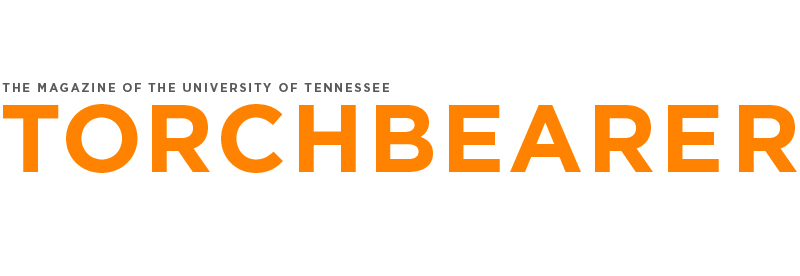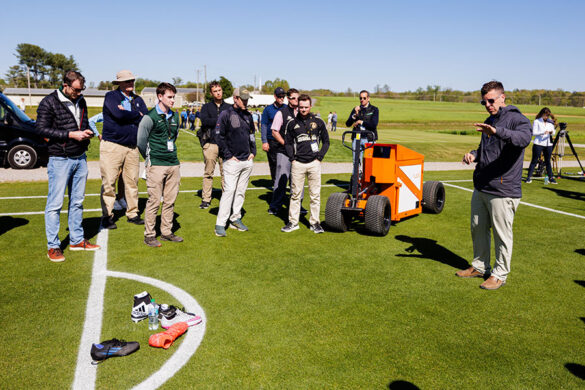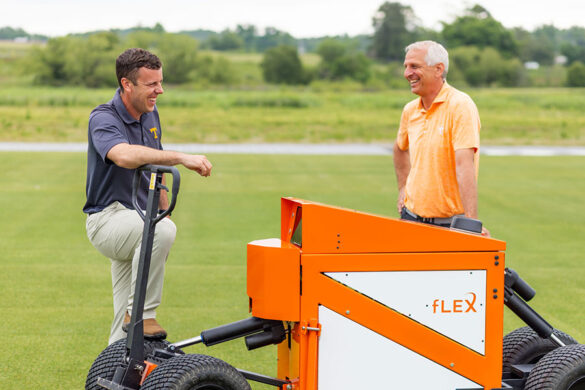In 2026, more than a billion people will be watching every kick, save, and tackle as the best soccer players in the world gather in North America to compete for the World Cup. And every game will take place on a natural turfgrass pitch perfected by researchers at the University of Tennessee.
FIFA, soccer’s global governing body, turned to John Sorochan, Distinguished Professor of Turfgrass Science and Management, to lead the research program that supports the design, installation, and management of the 16 stadium fields and dozens of training fields required for the biggest sporting event in the world. And Sorochan brought in John “Trey” Rogers, his mentor from Michigan State University, to collaborate on the five-year research project.
“One of the easiest decisions I have made around this tournament so far was the partnering of UT and MSU universities,” says FIFA Senior Pitch Management Manager Alan Ferguson. “Both already had world-leading reputations, both already led by world-leading turf professors. I didn’t want to reinvent the wheel—it was already here.”
The FIFA World Cup 26 competition will take place next June and July, with 48 teams playing across Canada, Mexico, and the United States. The competition will feature 104 games stretched across four time zones and three climatic zones.
Five of the stadiums are domed. Eight others require laying the new field over an artificial surface. Climatic differences call for various kinds of grass that require changes in irrigation and maintenance methods. And all of the pitches have to play identically, making the installation and maintenance of the pitches even more intricate.
It’s a challenge—and opportunity—that Sorochan has embraced.
For his team, World Cup 26 is a chance to put their expertise to use, solving a complex challenge on a world stage while also running experiments that will refine our understanding of how to create the most consistent and safe playing fields for all athletes.
For UT, it’s a global platform unlike any the university has had before.
“More than one-fifth of the world’s population will be tuning in to watch the World Cup, and when they do, they’ll see the most technically advanced turf in the world, created right here at UT,” says Chancellor Donde Plowman. “FIFA had never invested in turfgrass research before, but they saw the expertise they needed in John and his team. This is a chance to show the world why they should be turning to land-grant universities like ours to solve problems and create new technologies.”
The first test of the turf for this historic collaboration was the inaugural FIFA Club World Cup 2025, which was played in 12 venues across the United States from June 14 to July 13. Sorochan and the research team will gather information from the games and evaluate the pitches for further improvements to ready them for next summer’s games.
Sharing our evidence-based research for the World Cup 26 and with others from around the world means everything to me. Knowing that a fifth of the world is watching something you have been a part of—it’s hard to imagine the emotion that I’m going to feel.”
—John Sorochan
Playing the long game for the perfect pitch
Sorochan and his team have been working on the FIFA project for nearly three years, conducting more than 170 independent research projects to provide evidence-based data to FIFA.
“We began planning for this even before we received the official grant from FIFA so we could be as prepared as possible,” Sorochan says. “The universities both really stepped up, which was a tremendous testimony to the leadership believing in what the researchers were going to do for this. They had faith in us to do something like this.”
Since the ultimate goal of the project is to produce the perfect playing surface that ensures consistency and top performance from players, researchers had to find solutions for obstacles like grass maintenance inside fully roofed stadiums, conversion of artificial pitches, variations in surface standards, and differing grass types.
To do this, a state-of-the-art shade house was constructed at the UT Institute of Agriculture’s East Tennessee AgResearch and Education Center to replicate conditions inside a domed stadium, while MSU utilized a 23,000-square-foot asphalt pad at its Hancock Turfgrass Research Center to replicate the concept of laying turf on stadium floors. Baseline data was collected by members of the team at various stadium locations throughout Canada, Mexico, and the United States.
With athlete safety of the utmost importance, the natural surface required testing, but the right machine to do so didn’t exist. So Sorochan and Kyley Dickson (’12), associate director of UT’s Center for Athletic Field Safety, invented the fLEX Device, which mimics the rigors of game play by using a cleat and accurate sensors to ensure that surfaces meet FIFA’s industry standards for field consistency.
“The focus is on consistency and uniformity,” Sorochan says. “So when an athlete is running and cutting—whether in Miami, Mexico City, or Vancouver—they shouldn’t feel any difference underfoot. Likewise, when the ball strikes the surface and reaches them, it should behave consistently.”
UT’s worldwide exposure
On a chilly morning in February, FIFA President Gianni Infantino arrived in Knoxville just hours after he was featured on the broadcast of the Super Bowl. He wanted to see firsthand how the research team was progressing.
Infantino toured UT’s innovative turf research and development facility alongside FIFA Senior Advisor Carlos Cordeiro, Chief Business Officer Romy Gai, and Manolo Zubiria, chief tournament officer USA for FIFA World Cup 26, praising the groundbreaking efforts.
“With our internal team at FIFA, we have always been exploring ways to do things better, especially when you have a tournament that is lasting one month [or] a month and a half and is played in different cities,” Infantino said during the event. “Our team investigated and found the best people in the world to help us, and it’s fair to say that with Alan Ferguson we had this vision and joined forces to do something where the focus is the World Cup and the Club World Cup but from which the whole world will benefit.”
Thanks to the planning and execution of Assistant Professor Becky Bowling, UT has twice hosted FIFA Pitch Research Field Days, bringing together pitch managers, industry leaders, and representatives from FIFA member associations, confederations, leagues, and clubs worldwide. More than 200 turf specialists gathered to discuss the challenges and opportunities for the project, best practices, industry innovations, and pilot program results. In October 2024, Michigan State University played host to FIFA’s second Research Field Day at its research and development facilities in East Lansing, Michigan.
Installation of natural turfgrass at Mercedes-Benz Stadium in Atlanta, Georgia, for the FIFA Club World Cup. Photos by Steven Bridges/University of Tennessee
Invaluable educational experiences
One significant benefit of the project is the invaluable opportunity it provides for UT’s undergraduate and graduate students to engage in sports turfgrass research at the highest level—and secure jobs in the industry.
Ivan Navarrete (’23), who is one of two UT plant sciences alumni employed by FIFA, has benefited from the Turfgrass Management program’s extensive hands-on experiences and 100 percent job placement rate. He spent three months in Qatar based at Lusail Stadium—one of the eight stadiums built for the 2022 FIFA World Cup—and traveled to Mexico to help with research on grasses to be used in the World Cup 26 stadiums there.
“It’s been extremely rewarding to be exposed to and learn about the many industries and professionals who overlap with our line of work to make something as simple as a soccer match happen,” Navarrete says. “The combination of these experiences has been essential to being able to fulfill my role at FIFA.”
Sorochan knows from experience about the immeasurable benefits of working on such a massive project. His work as a student at the 1994 FIFA World Cup with Rogers helping to install a temporary grass field at the Pontiac Silverdome in Michigan sparked his passion for turfgrass research.
“I look at my students now getting to work on this and think, Where are they going to be 30 years from now and how is this going to change their life like it did mine?” he says. “It’s like a parent with your own kids. You see your students grow and evolve as they go from freshmen to seniors and represent the Big Orange and make us proud. They’re true Volunteers.”
Global, domestic, and local alliances
Sorochan’s co-principal investigator on the project is longtime friend and colleague John Stier, associate dean of UT’s Herbert College of Agriculture and a professor of plant sciences. Stier was a research assistant on the MSU team that worked on the 1994 FIFA World Cup.
Jim Brosnan, a plant sciences professor and director of the UT Weed Diagnostics Center, has also been working on FIFA research with graduate students. Brosnan’s research focuses on controlling unique and problematic turfgrass weeds, particularly those resistant to herbicides.
Sorochan and Brosnan were key in forging a $3.4 million partnership with Astroturf that led to the construction of the UT Center for Athletic Field Safety. The center, which opened in 2011, compares natural grass and synthetic playing surfaces to improve athletes’ performance, reduce injuries, and develop longer-wearing fields.
Sorochan said FIFA’s support of cutting-edge research at UT has the power to revolutionize the sports turf industry and leave a lasting legacy that will benefit millions long after a champion has been crowned and World Cup 26 has concluded.
“This has the ability to not only help professional soccer stadiums all over the world but professional baseball, NFL, and college fields to even little city parks and rec fields,” Sorochan says. “It’s extremely exciting to envision that kind of impact.”



